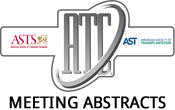2018 American Transplant Congress
Post-Transplant High Dose Cyclophosphamide Treatment Induces Thymus-Independent Immune Tolerance of Vascularized Composite Allografts via Complete Depletion of the Alloreactive TCR Repertoire.
Background: Treatment with PT/Cy in the setting of combined donor bone marrow transplantation and VCA has shown encouraging results with regards to chimerism induction and…2018 American Transplant Congress
Effect of Erythropoietin on Cardiac Allograft Survival in Non-Human Primates
1MGH, Boston; 2Icahn School of Medicine at Mount Sinai, New York.
Purpose: Tolerance of cardiac allografts has been achieved in cynomolgus monkeys for the first time via mixed hematopoietic chimerism and donor kidney co-transplantation, but the…2018 American Transplant Congress
T Cell Lineage Imbalance and Regulatory Immune Populations in HCC Patients Undergoing Downstaging While Waitlisted for Liver Transplantation
Purpose:In this study, we monitored peripheral lymphocyte lineage and regulatory immune populations in HCC patients undergoing DEB-TACE as a bridge to liver transplantation.Methods: Liver transplant…2018 American Transplant Congress
Anti-TIRC7 Antibody Acts Synergistically with Tacrolimus in Promoting Graft Survival in a Rat Kidney Transplant Model
Background: Induction of T cell immune response c-DNA (TIRC7) is restricted to activated lymphocytes. Modulation of TIRC7 signalling prevents immune activation specifically at the site…2018 American Transplant Congress
Ten Year Follow-Up of Islet Recipients on Anti-LFA1 Therapy: Over-Immunosuppression Leads to Operational Tolerance?
Introduction: Ten-year outcomes from a cohort of five pre-uremic islet transplant (txp) recipients treated with anti-leukocyte functional antigen-1 (LFA-1) antibody Efalizumab (EFA) revealed two patients…2018 American Transplant Congress
Changes in Phenotype, Immune Suppressive, Function, and Gene Expression of Myeloid Derived Suppressor Cells in Patients Given Combined Kidney and Hematopoietic Cell Transplants in a Tolerance Protocol
Tolerance induction after combined organ and hematopoietic cell transplantation can be achieved using conditioning with total lymphoid irradiation (TLI) and anti-thymocyte globulin (ATG), in both…2018 American Transplant Congress
Acute Murine CMV Infection Results in Loss of Intragraft CD73HIFR4HIPD1+ CD4 T Cells and Graft Rejection in Previously Tolerant Recipients
Background: Transplantation tolerance in human recipients has been achieved in recent trials. Nevertheless, the impact of highly prevalent and clinically relevant cytomegalovirus (CMV) infection on…2018 American Transplant Congress
Ex-Vivo Generation of Alloantigen-Specific Immunomodulatory Cells: Elucidating the Mechanistical Synergy of Cell Components
IntroductionRecently, Todo et al. reported that ex-vivo generated immunomodulatory cells induced operational tolerance in 7/10 liver transplanted recipients. To allow wide spread application, it is…2018 American Transplant Congress
AMD3100 (Plerixafor) as a Single-Dose Stem Cell Mobilizing Agent in Vascularized Composite Tissue Allograft (VCA) Transplantation in a Canine Model
PURPOSE:Vascularized Composite Allograft (VCA) transplantation is a clinical reality but limited by chronic immunosuppression and rejection. Current clinical tolerance protocols rely on recipient conditioning and…2018 American Transplant Congress
Donor Bone Marrow CXCR4+ Foxp3+ Treg Cells Are Essential for Costimulation Blockade-Induced Long-Term Survival of Murine Limb Transplants
1CHOP, Philadelphia; 2UPenn, Philadelphia.
Vascularized composite allotransplantation (VCA) would likely be more widely performed if maintenance immunosuppression was not essential for graft acceptance. Accordingly, we used murine models of…
- « Previous Page
- 1
- …
- 24
- 25
- 26
- 27
- 28
- …
- 57
- Next Page »
